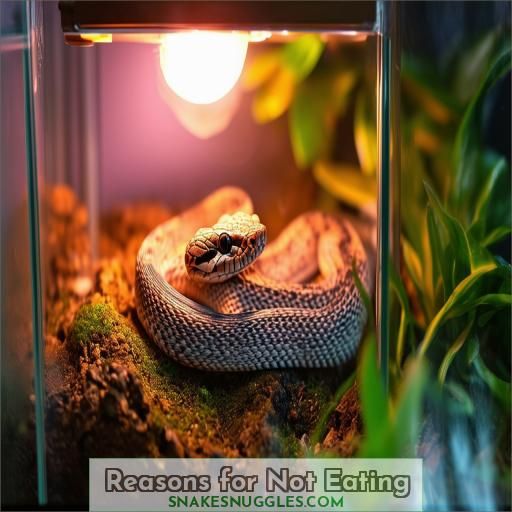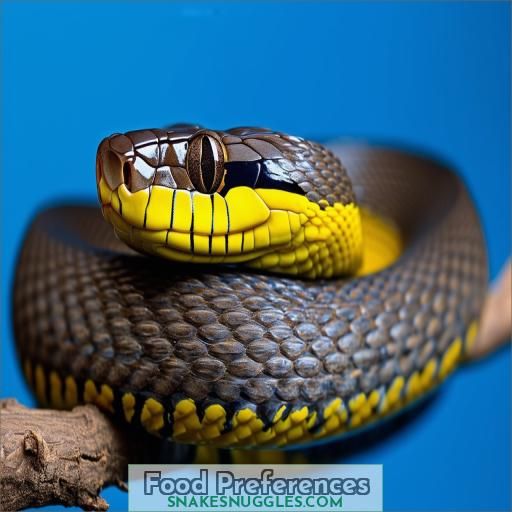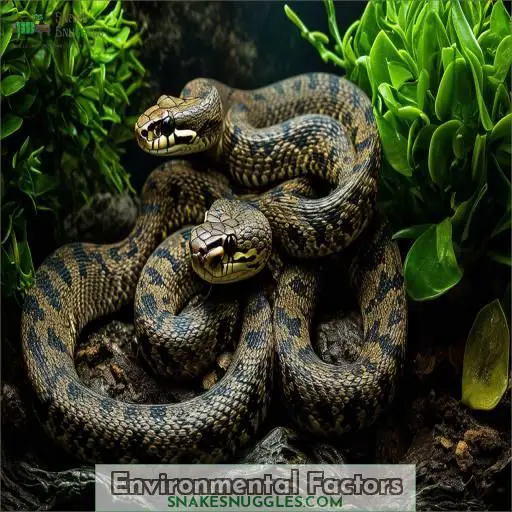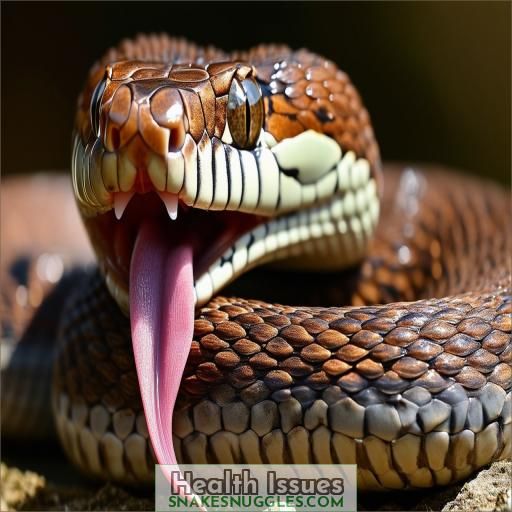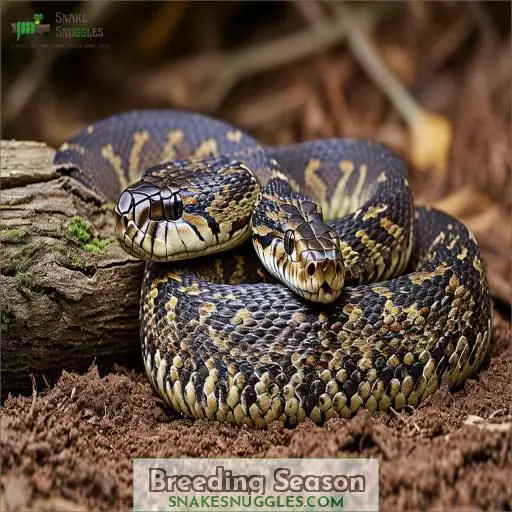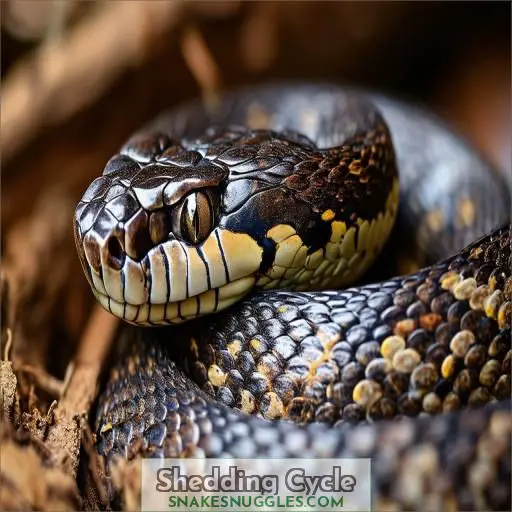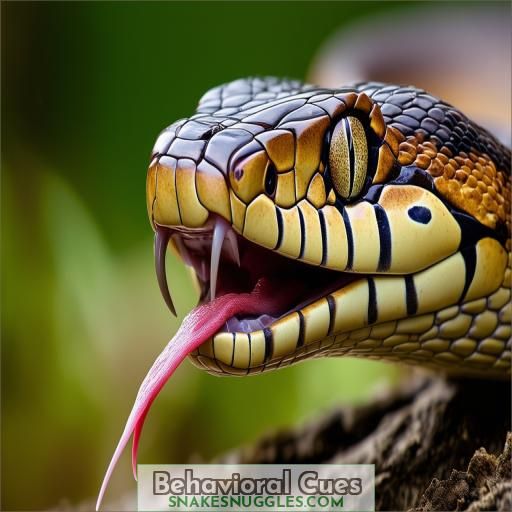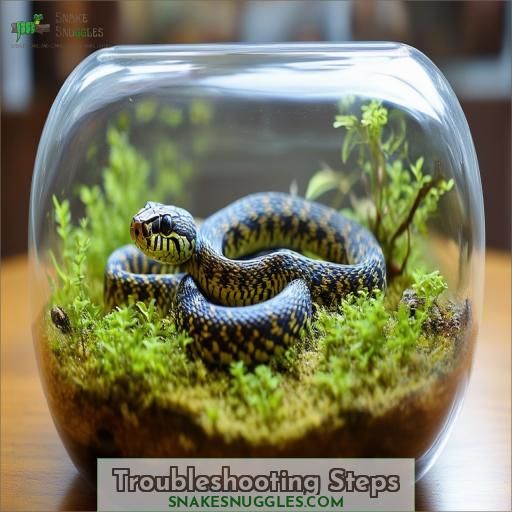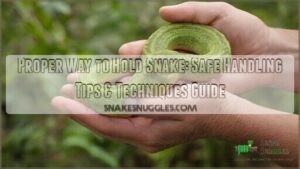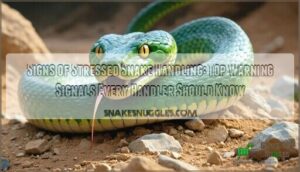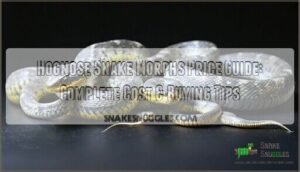This site is supported by our readers. We may earn a commission, at no cost to you, if you purchase through links.
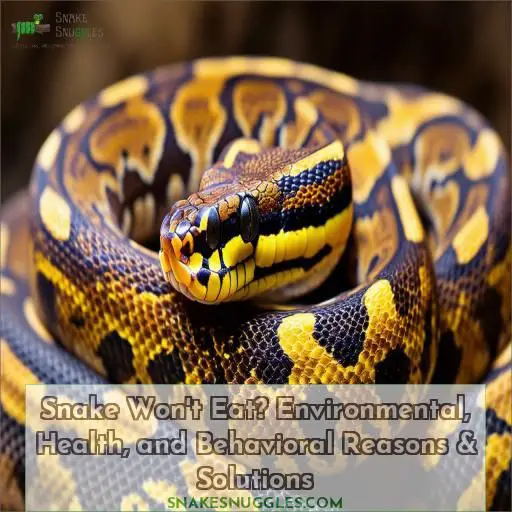 When your snake won’t eat, don’t panic.
When your snake won’t eat, don’t panic.
There could be environmental factors like improper temperatures or lack of hiding spots. Health issues, like parasites or mouth rot, might suppress its appetite too.
Your snake’s feeding behaviors evolve with age and seasons, so be patient.
First, verify that its enclosure meets all needs.
Then, observe if shedding or breeding could explain its fast.
Try varying prey size, type, and presentation methods – scents can help spark interest.
If issues persist, a vet visit may shed light on underlying causes.
With some sleuthing, you’ll soon have your scaly buddy munching away again.
Table Of Contents
- Key Takeaways
- Reasons for Not Eating
- Hunger Status
- Food Preferences
- Environmental Factors
- Health Issues
- Breeding Season
- Shedding Cycle
- Feeding Techniques
- Behavioral Cues
- Troubleshooting Steps
- Frequently Asked Questions (FAQs)
- What should I do if my snake won’t eat?
- How long can a snake go without eating?
- How do you stimulate a snake to eat?
- Is it normal for a snake to not eat for a month?
- How long can snakes safely go without eating?
- Can snakes become addicted to certain prey items?
- Do picky eater snakes require different housing setups?
- What are some safe force-feeding methods for snakes?
- Conclusion
Key Takeaways
- Don’t panic if your snake goes on a hunger strike – it could just be shedding its skin or feeling a little frisky during breeding season. A little sleuthing into their natural rhythms should shed some light on the situation.
- Even the pickiest of eaters can be tempted with the right treats. Try mixing up the menu with different prey sizes, live vs. frozen, or sprinkling on some irresistible scents. Presentation is key – snakes appreciate a little dinner theater!
- If environmental factors like temperature and humidity are out of whack, your snake may go into hibernation mode. Make sure their enclosure is a cozy oasis before you start scrutinizing their loss of appetite.
- When all else fails, it might be time for a reptile house call. Underlying health issues like parasites or infections could be the real party poopers killing your snake’s appetite. A vet visit could get to the root of the problem.
Reasons for Not Eating
A snake mightn’t eat due to environmental factors like incorrect temperature, humidity, or lighting, which can all disrupt its appetite. Health conditions such as parasites, infections, or injuries, as well as behavioral patterns, can also play significant roles in their feeding habits.
Environmental Factors Impacting Appetite
Guarantee that your snake’s habitat emulates its natural surroundings. Necessary environmental factors include:
- Temperature and Humidity: Maintain appropriate temperature and humidity levels to prevent distress and appetite loss.
- Daylight-Darkness Cycle: Regulate lighting to simulate natural day-night cycles.
- Substrate and Privacy: Provide suitable substrate and hiding spots for comfort (Source).
Health Conditions Affecting Feeding
Health conditions affecting your snake’s feeding include mouth rot, respiratory disease, and intestinal parasites, which can cause serious complications like obstructions and impactions. These issues often result in weight loss and a lack of appetite. Keep an eye on their age and make sure proper food and environment are provided (Source).
Behavioral Feeding Patterns
Behavioral feeding patterns in pet snakes can vary due to food preferences, timing, and environmental factors. Seasonal changes, molting, and stress impact appetite. To address anorexia in snakes, observe behavioral cues and adjust feeding times, ensuring the environment is suitable for your snake’s unique needs.
Hunger Status
Understanding your snake’s hunger status is key to solving feeding issues. Identifying hunger cues can help you determine if your snake is truly hungry or exhibiting signs of appetite suppression. Watch for:
- Meal Timing: Snakes have specific feeding schedules that differ by species. Make sure you’re following the appropriate timing.
- Self-feeding behavior: If your snake is actively hunting or displaying curiosity, these are good indicators of hunger.
- Food recognition: Check that your snake recognizes the food offered. Inconsistent substrate can cause confusion.
- Health indicators: Abnormal breathing, difficulty shedding, or underlying diseases may suppress appetite.
Check for urgency-care factors like extended fasting or visible weight loss, which may require a vet visit. Mastering your snake’s hunger cues leads to better feeding outcomes.
Food Preferences
Snakes sometimes refuse food due to their prey preferences. When your snake won’t eat, consider offering a variety of diet options. Some might favor mice, while others prefer rats or chicks. Adjust prey size to match your snake’s needs—too large or too small prey can be unappealing. Feeding frequency varies with species, so make certain you’re not over or underfeeding.
Experiment with live versus frozen prey, as some snakes may have a strong preference. Proper prey presentation matters too; use tongs or move the prey to mimic live movement. Always observe your snake’s behavior since stress and pre-shed conditioning might affect feeding. Consulting a veterinarian is essential if your snake won’t eat consistently or shows health issues.
Environmental Factors
You’ll want to guarantee the snake’s enclosure meets its environmental needs, as improper temperature, humidity, or lighting can disrupt its feeding behavior. Snakes are ectotherms, meaning their body temperature relies on external heat sources, so maintaining the right temperature gradient is essential for digestion and overall health.
Temperature
Maintaining the correct temperature is essential. You’ll need to provide a suitable range with a basking spot and temperature gradient. If it’s too cold, your snake may refuse to eat or develop respiratory problems. Use a heat lamp to create a thermal gradient, and don’t forget a cool hide. If the temperature is incorrect, consider alternative methods before giving up.
Humidity
You’ll also want to monitor the humidity levels. Snakes need the proper humidity to shed their skin. Provide a large water source and use the right substrate type and enclosure size with adequate hiding spots to maintain ideal humidity.
Lighting
You’ll need to mimic your snake’s natural lighting cycles. Provide basking spots with UVB lighting during the day, and dim lighting at night for nocturnal feeders. Improper lighting can disrupt feeding, so establish the correct photoperiod.
Health Issues
Health issues like parasites, infections, and injuries can greatly impact a snake’s appetite. You’ll want to closely monitor your snake for signs of these problems and consult a reptile veterinarian, as prompt treatment is important for restoring proper feeding behavior.
Parasites
You’ll want to check for parasites, which can wreak havoc on your snake’s appetite. Look for signs like weight loss, lethargy, and abnormal droppings. Proper quarantine and deworming are key for preventing parasite transmission and allowing your snake to bounce back to a healthy feeding routine.
Infections
You’ll want to watch out for infectious stomatitis (mouth rot), bacterial infections, fungal infections, respiratory infections, and parasitic infections. These can hamper your snake’s appetite, so maintain cleanliness and monitor for signs like mouth lesions or discharge. Catching infections early is key for successful treatment.
Injuries
If you suspect your snake has suffered an injury, it’s essential to have it examined by a reptile veterinarian. Trauma cases like:
- Bite wounds
- Broken bones
- Burns
- Fractures
Can lead to appetite loss and require urgent medical attention. Don’t delay seeking professional help for your pet’s well-being.
Breeding Season
Another reason your snake may not be eating is due to the breeding season. During this time, hormonal changes can suppress a snake’s appetite as they focus their energy on courtship behavior and egg production. Female snakes, in particular, may stop eating entirely as their bodies prepare for nesting and maternal instincts kick in.
| Breeding Behavior | Description |
|---|---|
| Courtship | Males become more active, seeking females |
| Hormonal Changes | Increased reproductive hormones |
| Egg Production | Females develop egg follicles |
| Nesting | Females search for suitable nesting sites |
| Maternal Instincts | Females become protective of eggs/young |
Stay patient during this natural process, as your snake’s appetite should return after breeding concludes. Provide ideal conditions, but avoid unnecessary handling that could disrupt breeding.
Shedding Cycle
Like many animals, snakes have a shedding cycle where they periodically shed their old skin. During this time, you may notice your snake becoming less active and refusing food. This is normal behavior, as shedding can be an energy-intensive process. However, keep an eye out for signs of dysecdysis, or abnormal shedding, such as:
- Incomplete shed, with skin remaining stuck on the body
- Prolonged "opaque" phase prior to shedding
- Rubbing excessively against objects to remove skin
- Extended period of not eating (over 2-3 weeks)
Proper humidity levels are important during this time to aid shedding. Avoid handling your snake unnecessarily, and don’t be alarmed if it refuses meals for a week or two. Once the shed is complete, normal feeding can resume.
Feeding Techniques
To entice a snake to eat, you can try different presentation methods like using tongs or leaving the food item in the enclosure. Food preparation techniques, such as heating prey to mimic a live animal’s warmth or using scent enhancers like fish oil, may also stimulate the snake’s feeding response.
Presentation Methods
You can try different presentation methods, like using tongs or leaving food in the enclosure. Enticing scents may also help. But don’t force it; snakes have unique feeding preferences and instincts. Observe their behavior closely to understand their cues and adjust your approach accordingly.
Food Preparation
You’ll also want to mull over food preparation. Ensuring proper food safety and using approved food additives can make prey more appetizing. Adjusting food temperature and presentation can similarly entice finicky eaters. Proper food storage prevents contamination while maintaining freshness.
Scent Enhancers
You can try using natural or artificial scents to tantalize your snake’s smell receptors. Rub food-based scents like chicken broth on prey items or use commercial lures. This enrichment technique mimics natural hunting cues, potentially stimulating feeding behavior.
Behavioral Cues
Another key aspect is observing your snake’s behavioral cues. Snakes exhibit specific behaviors when hungry or uninterested in food. Pay attention to signs such as:
- Tongue flicking
- Periscoping (raising head)
- Striking at prey
- Constricting feeding response
If your snake displays these hunger cues, yet refuses food, it could indicate an underlying issue. Conversely, a lack of these behaviors may signify your snake isn’t truly hungry. Additionally, consider factors like food quantity, size, timing, feeding location, and frequency – small adjustments can reignite their appetite.
Troubleshooting Steps
You’ll want to observe your snake’s behavior closely and check that all aspects of its husbandry are correct, such as temperature, humidity, and enclosure setup. If environmental conditions seem suitable, consider trying alternative food items or presentation methods to entice your snake to eat.
Observe Behavior
Before addressing your snake’s lack of appetite, closely observe its behavior for behavioral cues. Consider natural animal instincts and use this as a learning opportunity. Motivation triggers and emotional associations can provide insights into underlying causes.
Check Husbandry
You’ll want to double-check the enclosure. Is the substrate appropriate, with sufficient hiding spots and a water source? Verify the heat source is functioning properly, maintaining the ideal temperature and humidity gradient. Improper husbandry can quickly lead to poor appetite and health issues.
Try Alternative Foods
Sometimes snakes refuse meals due to food preferences associated with their natural snake diet and prey
. Try varying prey types based on seasonal availability, sizes, and scent preferences. Live prey avoidance can encourage eating frozen-thawed foods. Use tongs for safe, appealing food presentation to entice finicky eaters.
Frequently Asked Questions (FAQs)
What should I do if my snake won’t eat?
Ever wondered why your snake refuses food? Check its environment first – warmth, humidity, and hides create security. If conditions are right, try different prey or scenting techniques. With patience and care, your slithery pal will dine again.
How long can a snake go without eating?
A healthy snake can safely go several weeks without eating, but prolonged lack of food causes organ damage. Monitor your snake closely and consult a vet if it refuses food for over a month.
How do you stimulate a snake to eat?
Ever witnessed a hungry python stalking its prey? With patience and trickery like dangling mouth-watering morsels, you can entice even stubborn snakes. Switch up food, use scents, and present it enticingly – those slithery beauties won’t resist for long!
Is it normal for a snake to not eat for a month?
It can be normal for a snake not to eat for a month or longer, especially during cooler months when their metabolism slows down. However, prolonged fasting could indicate an underlying health issue requiring veterinary attention.
How long can snakes safely go without eating?
With a little luck, snakes can safely go without food for several months. However, ensuring their health requires closely monitoring weight loss – no more than 10% is ideal.
Can snakes become addicted to certain prey items?
Yes, snakes can develop strong preferences for certain prey items. Their predatory instincts make them prone to favoring the scent and movement of prey they’ve successfully hunted before.
Do picky eater snakes require different housing setups?
Yes, picky eaters may require different housing setups to cater to their preferences. You might need to adjust the temperature, hide spots, or even separate feeding areas to encourage eating habits.
What are some safe force-feeding methods for snakes?
Like coaxing a serpent from its lair, force-feeding should be an absolute last resort. Consult a veterinarian first; improper technique risks injury and stress for your scaly friend.
Conclusion
When your scaly friend’s snake won’t eat, don’t despair. Patiently troubleshoot by optimizing their environment, checking for health issues or breeding behaviors, and experimenting with varied prey sizes and presentation techniques. With diligent observation and appropriate adjustments, you’ll have your reptilian pal enthusiastically devouring meals again soon.

